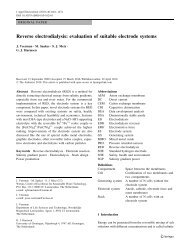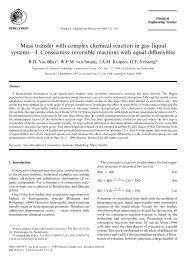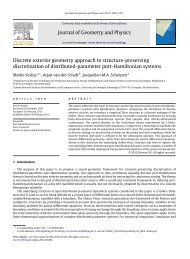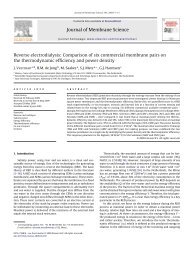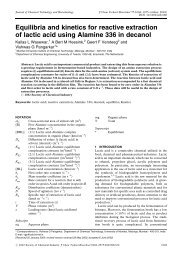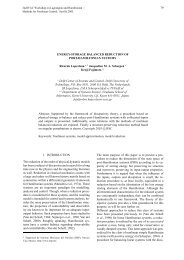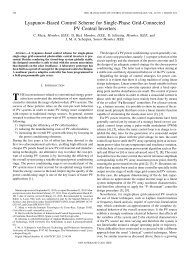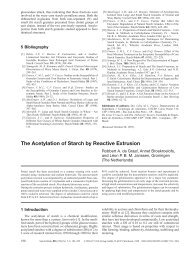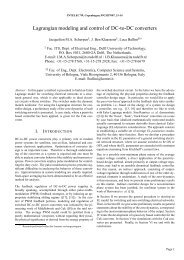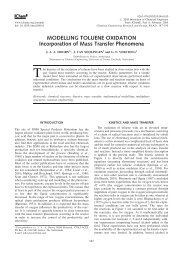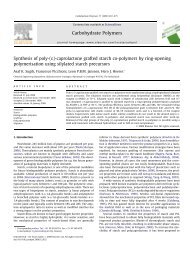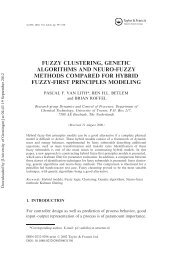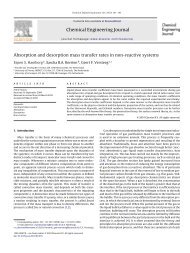Mass transfer with complex chemical reaction in gas—liquid ... - ITM
Mass transfer with complex chemical reaction in gas—liquid ... - ITM
Mass transfer with complex chemical reaction in gas—liquid ... - ITM
- No tags were found...
You also want an ePaper? Increase the reach of your titles
YUMPU automatically turns print PDFs into web optimized ePapers that Google loves.
R.D. Vas Bhat et al./Chemical Eng<strong>in</strong>eer<strong>in</strong>g Science 54 (1999) 137—147 145Fig. 8. Effect of irreversibility of <strong>reaction</strong> (1c) on enhancement for low mobility of C.Table 3Input parameters for chlor<strong>in</strong>ation of p-cresol <strong>in</strong> 1,2,4-trichlorobenzene(simulation results presented <strong>in</strong> Fig. 9)Parameter Value Units¹ 373.15 K[Cl ] 270 mol m[p-cresol] 4000 mol mk 0.19 m mol sk 0.015 m mol sD 5.410 m sD 3.910 m sD 3.310 m sk 10—10 ms(Taken from Pangarkar and Sharma, 1974).Liquid phase assumed to be unloaded.<strong>in</strong>formation of equilibrium constants for the system isavailable, both <strong>reaction</strong>s are assumed to be irreversible.By vary<strong>in</strong>g the mass <strong>transfer</strong> coefficient, k , the Hattanumber has been changed over a wide range (0.01(Ha(10) which covers all regimes of mass <strong>transfer</strong>. Thefully developed concentration profiles (at the end of theHigbie contact time) of p-cresol, MCPC and DCPC, werenumerically <strong>in</strong>tegrated over the penetration depth toobta<strong>in</strong> the average concentration of each species. TheSimpson’s 1/3rd rule was used for this purpose. Thesevalues were used to determ<strong>in</strong>e the differential selectivity,σ, and the overall conversion of p-cresol, ζ, def<strong>in</strong>ed as:σ" [MCPC](5a)[DCPC]ζ(%)" 1![p!cresol] (5b)where the square parenthesis <strong>in</strong>dicate concentrations. Itis important to note that the parameters, σ and ζ, arebased on concentrations <strong>with</strong><strong>in</strong> the liquid package and<strong>with</strong><strong>in</strong> a s<strong>in</strong>gle contact time.The variation of σ and ζ <strong>with</strong> the Hatta number hasbeen presented <strong>in</strong> Fig. 9. A significant <strong>in</strong>fluence of themass <strong>transfer</strong> parameters on selectivity is observed. Thishas been reported earlier, among others, by van de Vusse(1966a, b), Teramoto et al. (1970) and Pangarkar andSharma (1974). At high k values, correspond<strong>in</strong>g to lowHatta numbers, the rate of mass <strong>transfer</strong> is much greaterthan the k<strong>in</strong>etic rate so that the overall absorption isdeterm<strong>in</strong>ed by the rate of <strong>reaction</strong> (4a). As the Hattanumber <strong>in</strong>creases, the extent of <strong>reaction</strong> (4b) <strong>in</strong>creases aswell, thereby <strong>in</strong>creas<strong>in</strong>g the formation of DCPC. This, <strong>in</strong>turn, steadily reduces the selectivity towards MCPC.However, the production of MCPC is attractive only atsignificant conversions of p-cresol. As expected, the conversioncurve <strong>in</strong>creases <strong>with</strong> Hatta number as it dependsdirectly on the <strong>reaction</strong> between Cl and p-cresol [<strong>reaction</strong>(4a)]. Thus, <strong>in</strong>creas<strong>in</strong>g the Hatta number <strong>in</strong>creasesthe enhancement, that <strong>in</strong> turn <strong>in</strong>fluences conversion dueto the greater availability of Cl <strong>in</strong> the penetration depth.In actual operation a compromise will have to be metbetween maximis<strong>in</strong>g selectivity on the one hand andconversion on the other. It is <strong>in</strong>terest<strong>in</strong>g to note that theconversion curve does not form an <strong>in</strong>termediate plateauas is expected of consecutive <strong>reaction</strong> schemes. This isbecause at the process temperature (100°C), the value ofK is rather high (&810) so that <strong>reaction</strong> (4b)kicks-<strong>in</strong> even before <strong>reaction</strong> (4a) has reached its <strong>in</strong>f<strong>in</strong>iteenhancement value.4. ConclusionsA fundamental description of <strong>gas—liquid</strong> mass <strong>transfer</strong>for isothermal reversible consecutive <strong>reaction</strong>s has been



